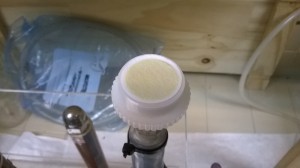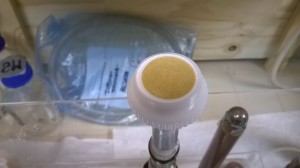Some weeks ago Ulf, Paul, Ted and I had an interesting meeting about an unplanned measurement which could complement the results that we were producing. It sounded great, and immediately we all began planning the organization, the sampling, the treatments, and how to coordinate the measurements here in Gran Canaria and in Kiel. A great collaboration, between great people!
Before continuing, you should know that I have always worked with water, clean water, pure dark blue seawater. In our field, the Marine Organism Ecophysiology Group (in Spanish: Grupo de Ecofisiología de Organismos Marinos, EOMAR) has to filter liters and liters of that blue seawater through a 0.7 micrometer glass fiber filter, because we study the microplankton metabolism at the enzymatic level.
From the beginning of the KOSMOS sampling, even without doing any other measurements, one could see qualitative changes in the microplankton community just by looking at the color of the filters! For instance, you could see them change during a bloom from pale yellow to a golden brown (or even to a lemon-green if the phytoplankton bloom is exceptionally strong!. In Kosmos GC 2.0 we are watching these differences between mesocosms day after day and it encourages us to take more samples and to want to work in the lab as soon as possible in order to know the analytical results!
In these pictures you can see the differences between M9 (a low-CO2 mesocosm) and M8 (a high-CO2 mesocosm) in day T39 of the experiment. Both filters are saturated, so the color shows clearly a different microplanktonic community.
In day T43, we took pictures of all the mesocosms, and these are the results from low-CO2 mesocosms to high-CO2 mesocosms:
Great, aren´t they?
Well, knowing this, where were we? Ah! Great collaboration between great people!! There was only one thing that I didn´t know, that I hadn´t done before: I hadn’t worked with samples from sediment traps!! So when Paul asked me, “How much sample will you need?”, I tried to reply (remember now, that in my mind, dozens of liters had been passing through the filters: “I don´t know, maybe 100ml”. Paul retorted rapidly, “That´s too much, don´t you think that 10ml could be enough?” I said, “Let´s see! We have to saturate the filter!” Lenni chimed in, “1ml, you will need 1 ml…” and I laughed, “Ha Ha Ha…”
Well… now I can say it: “Poor girl”…
A sediment trap is a device that collects all the particles that settle down through the water column (in this case, the mesocosm column). The sample includes all those kind of particles: aggregates, decomposed material, sinking particulate organic matter, and, of course, all the microbial community which remineralizes these particles.
But… how much decomposed material could be generated by tiny little microbes, tiny little phytoplankton, tiny little zooplankton or our beloved tiny little fish larvae? Not too much could be, no?
… Again… Poor girl!…
Initially, it was quite good. As well as in the water-filtration, samples looked quite different between low-CO2 mesocosms and high-CO2 mesocosms. Managing them was not as complicated as I had thought at the beginning, and we were able to homogenate the samples before filtering them without any problem. Week after week we saw how the deep water addition was affecting the mesocosms and we all were excited about the differences between them, and the increasing organic matter as the bloom develops.
Finally these are the filters from my last sediment-trap-sampling day. Most of them haven´t filtered more than 4ml of sample… and I do regret having used 3ml. As Lenni had said: “1ml, you will only need 1ml”.
In this picture, filters have been arranged in increasing order of ppCO2 too. Unfortunatelly no clear difference can be seen in these filters because all of them are hypersaturated! I hadn´t realized that several days after the phytoplankton bloom we would keep having so much detrital matter in the sediment traps!
The truth is that I want to believe they actually have a trend that makes the samples to be darker as the CO2 increases although in M8, the highest ppCO2 mesocosm, the color seems to be lighter than the others (but it is just because we filter less volume).
Who knows? and What does it mean? We will only know when all the Kosmos team treat the samples, do the measurements and analyze the extensive results!
PS: After several days of managing sediment trap samples, I realized another thing that I had not known before :
Do lovely-baby diapers smell like apple-pies? Well, neither do our microplankton’s clogged filters!



